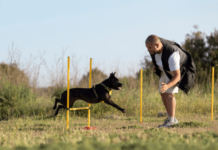Last Updated on May 18, 2024 by Dogs Vets
Dog Training Schools in London
When it comes to training your furry companion, enrolling them in a professional dog training school can make a world of difference. In London, there are several reputable dog training schools that can help you and your canine companion develop a strong bond and learn essential obedience skills.
Let’s explore the importance of professional dog training and the factors to consider when choosing a dog training school.
Importance of Professional Dog Training
Professional dog training plays a vital role in shaping your dog’s behavior and ensuring their overall well-being. Here are a few reasons why investing in professional training is beneficial:
- Effective Communication: Professional trainers are skilled in understanding canine behavior and can effectively communicate with your dog. They can teach your dog commands and cues, helping you establish clear communication and create a harmonious relationship.
- Socialization: Dog training schools provide a controlled environment for your dog to interact with other dogs and people. This exposure helps them develop social skills and become well-rounded members of the community.
- Behavioral Issues: Trainers can address and modify problematic behaviors such as excessive barking, aggression, or separation anxiety. They can tailor training programs to suit your dog’s specific needs, working towards a more balanced and obedient pet.
- Bonding and Trust: Through positive reinforcement techniques, trainers focus on strengthening the bond between you and your dog. Training sessions become an opportunity to build trust and enhance your relationship.
Factors to Consider When Choosing a Dog Training School
Selecting the right dog training school is crucial to ensure a positive learning experience for your furry friend. Here are some key factors to consider:
| Factor | Description |
|---|---|
| Trainer Qualifications | Look for trainers with certifications or memberships in recognized dog training organizations. This indicates their commitment to professional development and adherence to ethical training practices. |
| Training Methods | Understand the training methods used by the school. Positive reinforcement techniques, which reward desired behaviors, are generally considered effective and humane. |
| Facilities and Resources | Assess the training facilities, including indoor and outdoor areas, as well as the availability of equipment and tools. Adequate resources contribute to a conducive learning environment. |
| Client Testimonials | Read reviews and testimonials from current and past clients to gauge their satisfaction and success with the training programs. Positive feedback and success stories are indicators of a reputable school. |
| Scheduling and Location | Consider the convenience of the school’s schedule and its proximity to your location. Training sessions should be easily accessible to ensure regular attendance and consistency. |
| Cost and Value | Compare the cost of training programs offered by different schools. While price is a consideration, focus on the value provided, such as the expertise of the trainers and the comprehensiveness of the programs. |
By considering these factors and conducting thorough research, you can make an informed decision when choosing a dog training school in London.
Remember, professional training is an investment in your dog’s well-being and will set them up for a lifetime of good behavior and enjoyable companionship.
Top Dog Training Schools
When it comes to choosing a dog training school in London, it’s essential to consider various factors to ensure the best training experience for your furry friend. Here, we will explore three top dog training schools in London and highlight their unique offerings.
School A: Programs and Approach
At School A, they offer a comprehensive range of training programs designed to cater to dogs of all ages and breeds. Their approach focuses on positive reinforcement and reward-based training methods. By using treats, praise, and toys as motivators, they create a positive and enjoyable learning environment for dogs.
The programs at School A cover essential obedience training commands, such as sit, stay, and recall, as well as more advanced skills. Their training approach emphasizes building a strong bond between the owner and the dog, fostering trust and cooperation.
| Training Programs | Approach |
|---|---|
| Obedience Training | Positive reinforcement and rewards |
| Behavioral Modification | Addressing specific behavioral issues with positive techniques |
| Agility Training | Building coordination and mental stimulation through obstacle courses |
School B: Training Methods and Philosophy
School B takes a slightly different approach to dog training, focusing on balanced training methods. They combine positive reinforcement techniques with corrective measures to address behavioral issues effectively.
Their philosophy revolves around creating clear communication with the dog and establishing a hierarchy within the human-dog relationship.
The training methods used at School B involve rewarding desired behaviors and redirecting unwanted behaviors through corrections. Their trainers work closely with owners to develop a personalized training plan based on the specific needs and goals of each dog.
| Training Methods | Philosophy |
|---|---|
| Obedience Training | Balanced approach with positive reinforcement and corrective measures |
| Behavioral Modification | Addressing behavioral issues through clear communication and redirection |
| Agility Training | Enhancing coordination and mental stimulation through structured exercises |
School C: Trainer Qualifications and Experience
School C boasts a team of highly qualified and experienced trainers who are dedicated to providing top-notch dog training services. Their trainers have extensive knowledge of dog behavior and psychology, allowing them to tailor training programs to suit individual dogs’ needs.
The trainers at School C hold certifications in dog training and behavior modification, ensuring that they are well-equipped to handle various training challenges. They stay updated with the latest research and techniques in the field to deliver effective and safe training sessions.
| Trainer Qualifications | Experience |
|---|---|
| Certifications in dog training and behavior modification | Years of experience working with dogs of different breeds and temperaments |
| Continual education and staying updated with industry advancements | Proven track record of successful training outcomes |
By considering the programs, approach, training methods, philosophy, and trainer qualifications of different dog training schools, you can make an informed decision based on your dog’s specific needs and your training goals.
Remember to choose a school that aligns with your training preferences and the well-being of your beloved canine companion. For more information on dog training, check out our articles on dog obedience training in London and puppy training classes in London.
Specialized Training Programs
When it comes to dog training, specialized programs cater to specific needs and goals. Dog training schools in London offer a range of specialized programs designed to address various aspects of a dog’s behavior and skills.
Let’s explore three common specialized training programs offered by these schools:
Obedience Training
Obedience training is a fundamental program that focuses on teaching dogs basic commands and developing good manners. This program helps dogs learn essential skills such as sit, stay, come, and walking on a leash. Obedience training is beneficial for all dogs, whether they are puppies or adult dogs.
The goal of obedience training is to establish clear communication between the owner and the dog, promoting a well-behaved and obedient pet. Training methods may include positive reinforcement, clicker training, or other reward-based techniques.
Obedience training not only enhances the bond between the dog and owner but also ensures the dog’s safety and the well-being of those around them.
Behavioral Modification
Behavioral modification programs are designed to address specific behavioral issues in dogs. These programs are tailored to target and correct undesirable behaviors such as aggression, separation anxiety, excessive barking, or destructive chewing.
Behavioral modification programs aim to identify the root causes of these behaviors and implement strategies to modify them.
Qualified trainers or dog behaviorists in London work closely with the dog and the owner to understand the triggers and develop an appropriate behavior modification plan.
Techniques used may include desensitization, counterconditioning, or positive reinforcement. The goal is to help the dog overcome their behavioral challenges and develop more appropriate responses.
Agility Training
Agility training is a popular specialized program that focuses on enhancing a dog’s physical fitness, coordination, and mental stimulation. This program involves navigating through a series of obstacles such as tunnels, jumps, weave poles, and ramps.
Agility training not only provides physical exercise but also strengthens the bond between the dog and the handler.
Agility training is suitable for dogs of all sizes and breeds, as the obstacles can be adjusted to accommodate different skill levels. It helps improve a dog’s agility, speed, and problem-solving abilities.
The training sessions are typically conducted in a safe and controlled environment under the guidance of experienced trainers.
| Specialized Training Program | Description |
|---|---|
| Obedience Training | Teaches basic commands and manners. Enhances communication between owner and dog. |
| Behavioral Modification | Addresses specific behavioral issues such as aggression or anxiety. Modifies undesirable behaviors. |
| Agility Training | Improves physical fitness, coordination, and mental stimulation. Involves navigating through a series of obstacles. |
Specialized training programs offer targeted solutions to specific training needs. Whether you’re looking to establish obedience, modify behavior, or engage in an exciting agility course, London’s dog training schools have programs tailored to meet your dog’s unique requirements.
Remember to choose a program that aligns with your dog’s temperament, age, and goals for the best training experience.
Train you dog every day, even if you only have a minute or two, so something, a little everyday and you will see the results. This exercise is a stay in a position asked by the handler, whilst they leave and walk around their dog and then another and back. Puppy spaces available. pic.twitter.com/04KG2wTnZ8
— dog academy (@dogacademy1) May 18, 2024
Training Facilities and Resources
When selecting a dog training school, it’s essential to consider the facilities and resources available. A well-equipped training center can contribute to a successful and effective learning experience for both you and your canine companion.
Indoor and Outdoor Training Areas
A reputable dog training school will have dedicated indoor and outdoor training areas. The indoor facilities provide a controlled environment where dogs can learn and practice basic commands and obedience training. These spaces are especially useful during inclement weather or for dogs that may be easily distracted outdoors.
On the other hand, outdoor training areas allow for real-life simulations and practical training sessions. Dogs can practice their skills in a more natural environment, encountering various distractions and stimuli. This type of training helps them to generalize their learning and apply commands in real-world situations.
Equipment and Tools Available
The availability of a wide range of equipment and tools is another factor to consider when choosing a dog training school. Training aids such as leashes, collars, and harnesses may be provided or recommended by the school.
Additionally, agility equipment, such as jumps, tunnels, and weave poles, can be utilized for specialized training programs like agility training.
It’s important to ensure that the training school uses humane and positive reinforcement methods.
Tools or techniques that cause harm or distress to the dog should be avoided. Qualified trainers should be knowledgeable in the proper use of equipment and choose methods that prioritize the well-being and safety of the dogs.
Group Classes vs. Private Sessions
Dog training schools typically offer two main formats for training: group classes and private sessions. Both options have their advantages and may cater to different training needs.
Group classes provide an opportunity for dogs to socialize and learn in a group setting. They are beneficial for dogs that need to improve their social skills and interact with other canines. Group classes also allow owners to learn from each other and share experiences.
However, it’s important to ensure that the class sizes are manageable, allowing for individual attention and guidance from the trainers.
Private sessions, on the other hand, offer a more personalized approach. The focus is solely on you, your dog, and your specific training goals. This format allows for targeted training and addressing specific behavioral issues.
Private sessions are particularly useful for dogs with complex or severe behavior problems that require individual attention and guidance from a dog behaviorist.
The choice between group classes and private sessions ultimately depends on your dog’s needs and your training preferences. Some schools may offer a combination of both options, providing flexibility and tailored programs to suit different training requirements.
By considering the training facilities and resources offered by different dog training schools, you can make an informed decision and choose the one that aligns with your dog’s needs and training goals.
Remember to check for positive client testimonials and success stories to further validate the school’s reputation and track record.
Client Testimonials and Reviews
When looking for a top dog training school in London, it’s important to consider the experiences and feedback of current and past clients. Client testimonials and reviews provide valuable insights into the effectiveness and quality of the training programs offered.
In this section, we will explore the significance of client feedback, success stories, results, and the overall reputation of dog training schools.
Feedback from Current and Past Clients
One of the best ways to gauge the quality of a dog training school is by listening to the feedback from their clients. Current and past clients can provide valuable insights into their experiences, the training methods employed, and the overall satisfaction with the programs.
Positive feedback from clients is often an indicator of a reputable and effective dog training school.
Success Stories and Results
A reputable dog training school will have a track record of success stories and positive results. These success stories can be a testament to the effectiveness of the training programs and the expertise of the trainers.
Look for dog training schools that showcase their success stories and highlight the progress and achievements of their clients’ dogs.
Reputation and Word of Mouth
The reputation of a dog training school is another important factor to consider. Positive word of mouth from other dog owners, trainers, and even veterinarians can provide valuable insights into the reputation and credibility of a training school.
Consider seeking recommendations from trusted sources or online communities dedicated to dog training.
To make an informed decision about which dog training school in London is right for you and your furry friend, it’s crucial to take into account client testimonials, success stories, and the overall reputation of the school.
By considering the experiences and feedback of others, you can gain a better understanding of the quality of the training programs and the likelihood of achieving your training goals.
Remember, every dog is unique, so choose a dog training school that aligns with your specific needs and goals.
Making the Right Choice
When it comes to choosing the right dog training school in London, there are several factors to consider. Making an informed decision ensures that you find a training program that suits both you and your furry friend. Here are some key aspects to keep in mind.
Scheduling and Location Convenience
Finding a dog training school that offers flexible scheduling and is conveniently located can make a significant difference in your overall experience. Look for schools that offer training sessions at times that align with your availability.
Additionally, consider the location of the school and whether it is easily accessible for you and your dog. Convenient scheduling and location can make attending classes more convenient and enjoyable for both you and your canine companion.
Cost and Value of Training Programs
Understanding the cost and value of training programs is essential when making your decision. The cost of dog training programs can vary depending on factors such as the duration of the program, the expertise of the trainers, and the training methods employed.
It’s important to evaluate the value you will receive in return for the cost of the program.
Consider the qualifications and experience of the trainers, the training methods used, and the success rate of the school in achieving desired results. This will help you determine whether the cost of the program aligns with the value you expect to receive.
Personalized Assessment and Recommendations
A reputable dog training school will typically offer a personalized assessment of your dog’s behavior and training needs. This assessment allows the trainers to understand your dog’s specific challenges and tailor the training program accordingly.
Look for schools that prioritize individualized attention and provide recommendations based on your dog’s unique personality and requirements. A personalized approach ensures that your dog receives the most effective training methods and that the training program is tailored to address their specific needs.
By considering factors such as scheduling and location convenience, the cost and value of training programs, and personalized assessment and recommendations, you can make an informed decision when choosing a dog training school in London.
Remember to conduct thorough research, read client testimonials and reviews, and consider the specific needs of your dog. Finding the right training school will set you and your furry friend on the path to a successful and enjoyable training journey.
Fact Check
We strive to provide the latest valuable information for pet lovers with accuracy and fairness. If you would like to add to this post or advertise with us, don’t hesitate to reach us. If you see something that doesn’t look right, contact us!

















